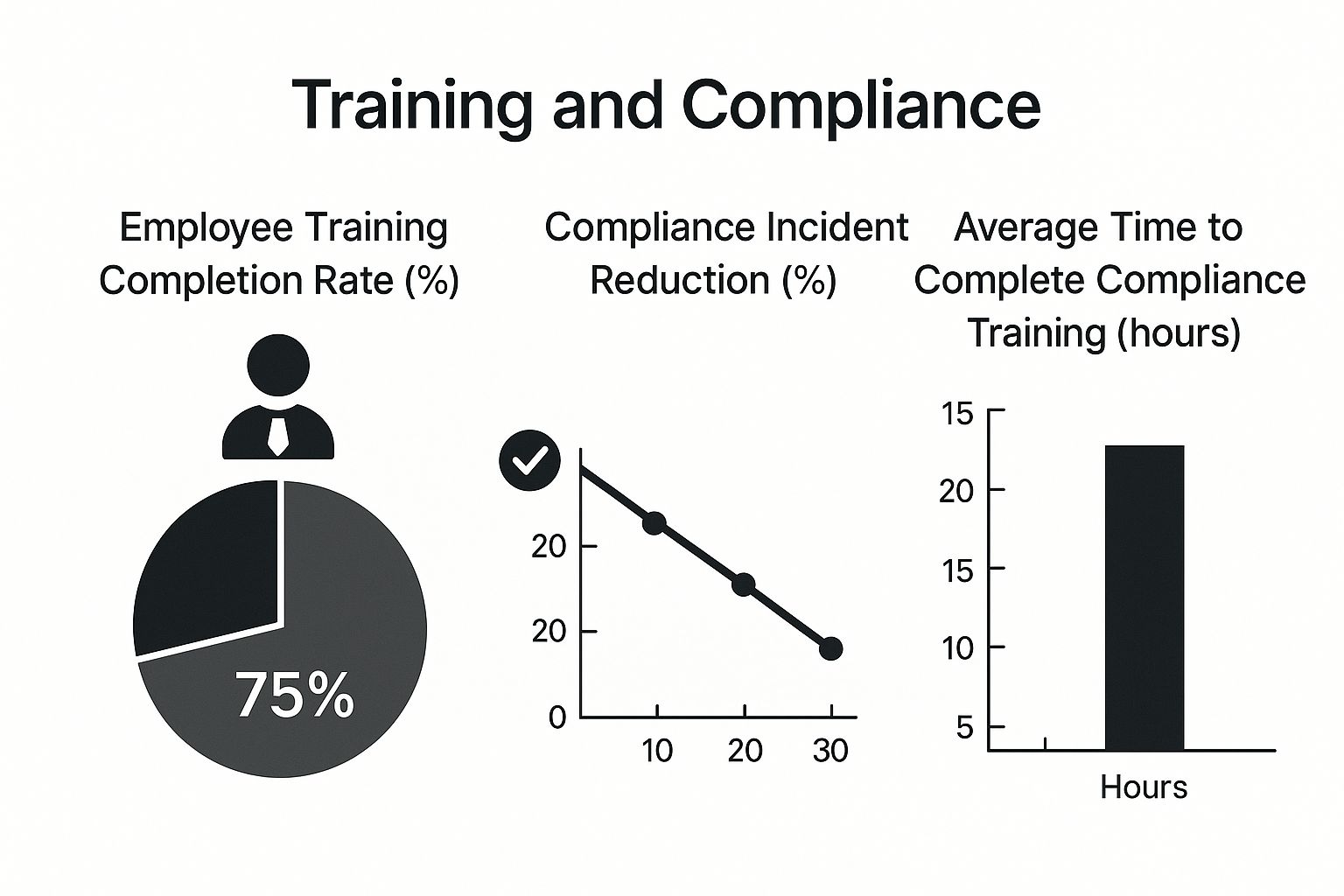Why HR Compliance Training Matters More Than Ever

The business world is constantly changing, and so are the rules. HR compliance training, once a mere formality, is now essential for any thriving organization. This shift is driven by increasingly complex legalities, from evolving labor laws to new ethical discussions around artificial intelligence. Ignoring compliance can have serious repercussions, so organizations must be proactive.
The Real Cost of Non-Compliance
Legal penalties for non-compliance can be devastating. Heavy fines can cripple a company's finances, while lawsuits drain resources and tarnish reputations. Non-compliance can also erode employee trust, leading to lower morale and productivity. In extreme cases, it can even shut down a business, temporarily or permanently. These risks underscore the need for robust HR compliance training programs.
HR Compliance in 2025
HR compliance training has become essential in today's intricate regulatory environment. By 2025, HR teams are expected to handle labor, AI, and ethical risks even more effectively. This requires strategic planning to navigate changing regulations and technological advances, ensuring compliance training is effective and aligns with company goals.
Technology's Role in Compliance
A key aspect is using technology to improve compliance. According to a recent report, 55% of companies use HR tech for compliance and security—twice the percentage from previous years. This shows a significant move toward technology-driven compliance solutions. This tech integration is vital for managing the complex legal landscape, especially for global businesses where compliance needs vary across regions. Explore further: Find more detailed statistics here
From Checkbox to Competitive Advantage
Forward-thinking companies realize HR compliance training isn't just about avoiding penalties; it's about building a better business. Fostering a culture of ethics and respect improves employee engagement and attracts top talent. This creates a workplace where everyone feels valued and secure.
Building a Culture of Compliance
Building a true culture of compliance requires more than checking boxes. It demands ongoing education and open communication. This means creating engaging training relevant to employees' daily work, plus regular updates and chances to ask questions. This proactive approach weaves compliance into the company culture.
Empowering Employees Through Compliance
Furthermore, it empowers employees to take ownership of their role in maintaining a compliant and ethical workplace. This shared responsibility is crucial for long-term success. By shifting from reactive to proactive, companies can transform HR compliance training into a powerful tool for positive change.
Building HR Compliance Programs That Actually Work

What makes a truly effective HR compliance training program? It's about fostering a genuine culture of understanding and ethical conduct. Instead of just ticking boxes, compliance should be woven into the fabric of your organization. It should become a natural part of how things are done.
Key Components of Effective Programs
Truly effective HR compliance programs share some important qualities. They emphasize practical application, bringing complex concepts to life with real-world examples. This helps employees connect the dots between abstract rules and their everyday tasks.
They also prioritize interactive learning. Engaging different learning styles through simulations, quizzes, or discussions makes training stick. And finally, these programs recognize the value of ongoing feedback and evaluation to keep the training relevant and impactful.
- Clear Objectives: Define your goals. Are you aiming to reduce specific incidents, boost employee understanding, or cultivate a more ethical workplace? Knowing your destination helps you chart the right course.
- Targeted Content: Recognize that one size doesn't fit all. Tailor your content to different roles and responsibilities, making it directly relevant to each employee's work.
- Engaging Delivery: Ditch the dry lectures. Embrace interactivity, real-world scenarios, and even a touch of humor to make learning enjoyable.
- Regular Reinforcement: Compliance isn't a one-and-done deal. Regular refreshers and updates keep it top of mind.
- Measurement and Evaluation: Track key metrics, like policy violations and training completion rates, to gauge your program's success and identify areas for improvement.
To illustrate these components, let's explore a table outlining essential elements of a successful HR compliance training program.
Introducing the table below, which offers a clear overview of the core components necessary for successful HR compliance training. This table acts as a guide to develop and maintain an impactful program within your organization.
| Training Component | Description | Implementation Considerations | Success Metrics |
|---|---|---|---|
| Code of Conduct Training | Establishes ethical expectations and behavioral guidelines | Use real-life scenarios and interactive discussions | Reduced ethics violations, increased reporting of misconduct |
| Harassment Prevention | Focuses on preventing and addressing workplace harassment | Offer role-playing exercises and clear reporting procedures | Decreased harassment complaints, improved employee confidence in reporting |
| Discrimination Awareness | Educates employees about various forms of discrimination | Incorporate case studies and legal updates | Reduced discrimination claims, increased diversity and inclusion |
| Data Privacy and Security | Covers handling sensitive information and protecting company data | Provide practical examples of data breaches and security best practices | Fewer data security incidents, improved compliance with data protection regulations |
| Workplace Safety | Trains employees on safety procedures and hazard prevention | Conduct hands-on training and safety drills | Lower accident rates, increased employee awareness of safety protocols |
This table showcases the critical aspects of HR compliance training, encompassing everything from defining the core components to measuring their effectiveness. By focusing on these elements, organizations can build programs that truly make a difference.
Measuring the Impact of Your Program
Simply tracking completion rates doesn't tell the whole story. Leading organizations are adopting more sophisticated methods to measure real behavior change. Tracking reported incidents related to specific compliance areas, like harassment or discrimination, provides a much clearer picture of a program's impact. Gathering qualitative feedback through surveys or focus groups also reveals valuable insights into employee understanding and perceptions.
You can learn more about general Compliance. Also, consider how understanding the principles of SEO can help your program reach a wider audience: How to master your SEO on your WordPress website.
Creating a Culture of Compliance
The most successful programs go beyond mere training. They cultivate a culture where ethical considerations are embedded into every facet of the organization, from hiring to performance reviews. In this environment, compliance becomes everyone's responsibility, contributing to a safer and more respectful workplace. This not only minimizes legal risk, but also strengthens your organization's reputation and helps attract and retain top talent.
Transforming Compliance Training Into an Engagement Tool

Forget those days of dull, uninspiring HR compliance training. Forward-thinking companies are now transforming this necessary process into a powerful opportunity. It's a chance to boost employee engagement and build a stronger, more ethical workplace. This shift requires a change in mindset. Instead of a tick-box exercise, HR compliance training becomes a vital investment in your team.
Engaging Employees Through Relevance
Effective HR compliance training hinges on relevance. Connect the training content to your employees' daily work lives. Instead of reciting legal jargon, explain how compliance principles apply to their roles and responsibilities. This personalized approach boosts engagement and helps employees truly understand why compliance matters in their day-to-day work. When developing your HR compliance training program, consider exploring platforms like Haekka Training.
Using storytelling and real-world examples can also make abstract compliance concepts more relatable and memorable. Show the potential consequences of non-compliance through realistic scenarios. This will help employees grasp the importance of following policies and procedures.
Employee engagement is a critical outcome of thoughtful HR compliance training. Studies show that 92% of employees believe well-planned training programs positively impact engagement levels. This engagement is vital for creating a culture of compliance. Explore more employee training statistics. Engaged employees are more likely to follow compliance policies, minimizing non-compliance risks.
Fostering a Culture of Feedback and Continuous Improvement
Engaging HR compliance training thrives on feedback. Actively solicit employee feedback to understand what's working, what's not, and how training can be improved. Go beyond simple satisfaction surveys. Implement more in-depth feedback mechanisms, such as focus groups or individual interviews. For further insights, explore resources like How to master your website design.
Connecting Compliance to Career Success
Effective compliance training programs clearly link compliance to career advancement. Show employees how ethical conduct positively impacts professional development and career growth. This motivates them to embrace compliance as a valuable skill. You could demonstrate how compliance skills are in high demand or offer specialized training programs to further develop their expertise. This approach positions compliance not as a burden, but as a path to professional growth.
Measuring Engagement Impact
Measuring compliance training's true effectiveness goes beyond mere completion rates. Implement frameworks to assess actual behavior change and long-term impact. For instance, track the number of reported compliance violations. This provides a concrete measure of how training translates into real-world improvements. A data-driven approach helps demonstrate the return on investment of training and allows you to continuously refine your programs for maximum impact.
Leveraging Technology To Revolutionize HR Compliance
Technology is transforming HR compliance training. It's not just about boosting efficiency anymore; it's about creating engaging experiences for employees and fostering a genuine culture of compliance. This evolution is fueled by innovative platforms that use technology to make training more effective and impactful.
AI-Powered Microlearning and Immersive Simulations
Many organizations are embracing AI-powered microlearning, which delivers small, focused training modules tailored to individual needs and learning styles. This personalized approach boosts knowledge retention and engagement.
Immersive simulations are also gaining traction, offering realistic scenarios where employees can practice applying compliance principles in a safe, virtual environment. This practical experience leads to better decision-making on the job. Learn more in our article about the GNU General Public License.
Evaluating Technology Solutions For Your Needs
Choosing the right technology requires careful consideration. Think about your industry-specific needs, organizational culture, and overall compliance requirements. For instance, a healthcare organization will have vastly different technology needs than a tech startup. Factors like the size of your workforce, budget, and the complexity of the regulations you adhere to will influence your decisions.
To help illustrate the positive impact of technology in HR compliance, take a look at the infographic below. It compares employee training completion rates with compliance incident reduction, and shows the average time to complete training.

As the infographic shows, using technology not only boosts training completion rates but also dramatically reduces compliance incidents. The decreased training time leads to faster onboarding and more efficient use of employee time. This clearly demonstrates the return on investment (ROI) of technology in HR compliance.
To further help you evaluate technology solutions, we've compiled a comparison table. It highlights key features, suitability for different organizational needs, limitations, and cost considerations of various HR compliance training technology platforms.
Introducing the "HR Compliance Training Technology Comparison" table. This table offers a detailed comparison of different technology platforms and tools, designed to help you make informed decisions about the best solution for your organization.
| Technology Solution | Key Features | Best Suited For | Limitations | Cost Considerations |
|---|---|---|---|---|
| Learning Management Systems (LMS) | Course management, tracking, reporting, and delivery | Organizations with a large number of employees and diverse training needs | Can be complex to implement and manage | Typically subscription-based, pricing varies depending on features and number of users |
| Microlearning Platforms | Bite-sized modules, mobile-first design, gamification | Organizations looking to improve engagement and knowledge retention | Limited content depth | Subscription-based, often more affordable than full-fledged LMS |
| Virtual Reality (VR) Training | Immersive simulations, realistic scenarios, experiential learning | Industries with high-risk environments or complex procedures | High initial investment in hardware and software | Can be significant, but potential cost savings in reduced incidents |
| Mobile Learning Apps | On-demand access, personalized learning paths, push notifications | Organizations with a mobile workforce | Requires employees to have access to mobile devices | Subscription-based, often bundled with LMS |
The table above highlights the diverse landscape of HR compliance training technology. Each solution offers unique strengths and weaknesses, emphasizing the importance of aligning technology choices with specific organizational needs and goals.
Implementation Strategies and Measuring ROI
Successfully integrating new technology requires a well-defined strategy. Address potential resistance by clearly communicating the benefits to employees and offering adequate training and support.
Go beyond simply monitoring completion rates. Focus on assessing the tangible effects of training on employee behavior and business outcomes.
Future-Proofing Your Technology Investments
The world of regulations is constantly changing. Select technology solutions that are adaptable and scalable, ensuring your investment remains valuable as new regulations appear. Look for platforms that provide regular updates and support to stay ahead of the curve. This proactive approach helps avoid costly revisions and keeps your compliance program strong and effective. By embracing technology, organizations can shift HR compliance training from a required task to a strategic asset, cultivating a culture of ethics and responsibility while driving positive business results.
Mastering Global Compliance Across Cultural Boundaries
For multinational organizations, HR compliance training isn't a simple translation project. It's about understanding the cultural nuances that shape workplace dynamics around the world. What's acceptable in one culture might be offensive or even illegal in another. This section explores how to navigate these complexities.
Respecting Local Cultural Contexts While Maintaining Standards
Global compliance leaders know the secret: balance global consistency with local adaptation. They build core compliance principles that apply everywhere, yet allow flexibility in implementation. For example, a company-wide policy against harassment should be universal, but the training scenarios can reflect local cultural norms.
Language is another key factor. Offering training in multiple languages isn't enough. The content must resonate culturally. Think about using local idioms, culturally relevant examples, and adjusting the tone and style of communication to truly connect.
Addressing Region-Specific Regulations
Navigating the global regulatory landscape is crucial. Global HR compliance involves many legal requirements that change by region. Companies must tailor training to meet the specific legal standards of each place they operate. The EU's General Data Protection Regulation (GDPR) and the US's Americans with Disabilities Act (ADA) are just two examples of the many regulations companies must follow.
Best practices include regular audits, transparent communication, and robust training programs that are culturally sensitive and relevant to the specific legal environment. Effective compliance training can help avoid penalties and build a positive global reputation. Learn more about global HR compliance. Another helpful resource: How to master the GNU General Public License.
Navigating Cultural Sensitivities
Topics like harassment and discrimination need careful consideration. Cultural perceptions of inappropriate behavior differ greatly. Training must address these differences while upholding company values.
This might involve using local experts to develop training or incorporating culturally specific case studies. For instance, physical contact that's normal in some cultures could be harassment in others.
Operational Strategies for Global Implementation
Managing global compliance training has unique logistical hurdles. Consider time zones when scheduling training. Ensure materials are accessible across various systems. Implement strategies to track completion across regions and languages.
This might involve using a centralized learning management system (LMS) or offering training in different formats to suit various learning styles and technical capabilities.
Global HR compliance training isn't one-size-fits-all. It’s an ongoing journey of learning, adapting, and refining your approach to ensure programs are both effective and culturally sensitive. This commitment to improvement helps maintain high ethical standards while building a respectful and inclusive global workforce.
Measuring What Matters in HR Compliance Training
Completion rates are important, but they only scratch the surface of training effectiveness. Just because someone sits through a training session doesn't mean they absorbed the information or will apply it on the job. To truly understand the value of your HR compliance training, you need to look beyond simple attendance and explore metrics that reveal its real impact. Ask yourself: Is your training truly making a difference? Is it leading to fewer harassment complaints? Are employees demonstrating a deeper grasp of data privacy? These are the kinds of questions meaningful measurement should answer. You might also be interested in learning more about open-source licenses: How to Master Open Source Licenses.
Beyond Completion Rates: Measuring Behavioral Impact
Shifting from a focus on completion to a focus on impact requires a new perspective. It means considering both immediate learning outcomes and long-term behavioral changes. Quizzes and assessments administered immediately after training can offer a snapshot of knowledge gained. But the real measure of success lies in observing how that knowledge translates into action in the workplace.
One powerful strategy is to track key performance indicators (KPIs) that directly relate to compliance areas. For example, if you've provided training on harassment prevention, monitor the number of harassment complaints filed afterward. A decline in complaints could suggest that the training is effectively influencing behavior. Also, consider tracking near-miss incidents. These are situations that had the potential to become compliance violations but were averted, often due to heightened awareness and proper training.
Gathering Qualitative Feedback to Uncover Blind Spots
Quantitative data, such as incident rates, is valuable, but don’t underestimate the power of qualitative feedback. Soliciting employee perspectives through surveys, focus groups, or individual interviews can illuminate potential blind spots within your compliance program. Employees may express confusion about particular policies or share concerns about specific training methods. This feedback offers a chance to refine your program and ensure it effectively addresses employee needs, ultimately boosting its impact.
Demonstrating ROI: Presenting Compliance Metrics to Executives
Communicating compliance metrics to executives requires a strategic approach. Focus on connecting training outcomes to tangible business results. Frame your data in terms of return on investment (ROI). For instance, demonstrate how a reduction in incidents translates to cost savings, perhaps by decreasing legal fees or avoiding regulatory penalties. Emphasize how improved compliance strengthens the organization's reputation and boosts employee retention.
Effective data visualization is essential. Employ dashboards and charts to present complex information clearly and concisely. Highlight key trends and takeaways, concentrating on the most significant results. By showcasing the tangible benefits of HR compliance training, you can secure buy-in from leadership and ensure continued support for your program. Clearly illustrate how compliance training not only mitigates risk but also positively affects the bottom line.
The Future of HR Compliance Training Is Already Here
The next generation of HR compliance training is blossoming before our eyes, seamlessly weaving together technology, psychology, and organizational design. This isn't simply a matter of checking boxes and keeping pace with the latest regulations. It's about fostering a vibrant culture where compliance is woven into the very fabric of the employee experience.
Personalized Learning Through AI
Imagine a world where AI-powered adaptive learning paths tailor training to each employee's individual risk profile. This means a sales representative handling sensitive customer data receives training distinct from a warehouse worker. The sales representative might delve deeper into data privacy and security, while the warehouse worker focuses on workplace safety. This personalized approach ensures training resonates with each individual, leading to enhanced knowledge retention and practical application.
Immersive Technologies for Deeper Engagement
Traditional compliance training can often feel dry and disconnected. Immersive technologies like Virtual Reality (VR) and Augmented Reality (AR) are transforming this landscape. They create emotional connections to compliance concepts, making the learning experience more impactful and memorable. Picture a VR simulation where employees witness the repercussions of a data breach firsthand. This type of immersive learning cultivates a deeper understanding of compliance risks and inspires proactive behavior change.
Adapting to Demographic Shifts and Evolving Work Arrangements
Today's workforce is a tapestry of diverse learning styles, generational preferences, and work arrangements. Future HR compliance training must embrace these differences. This involves incorporating flexible delivery methods, such as microlearning and mobile-first training, to cater to a range of learning needs. Furthermore, the content must be inclusive and address the unique compliance challenges encountered by remote workers, gig workers, and international teams.
Staying Ahead of the Curve
Regulations are in constant flux. To avoid endless program overhauls, future compliance training needs to be agile and adaptable. Leveraging technology platforms that provide real-time updates on regulatory changes and allow for easy content customization is key. In addition, continuous monitoring and feedback are essential for proactively pinpointing compliance gaps and refining training programs to address emerging risks. This proactive approach empowers organizations to remain compliant without perpetually rebuilding their training from the ground up.
Take your HR career to new heights and contribute to a more ethical and compliant workplace. Explore the comprehensive HR certifications available through the Global Human Resource Institute at https://www.globalhrinstitute.website and become a leader in the future of HR compliance.




0 Comments